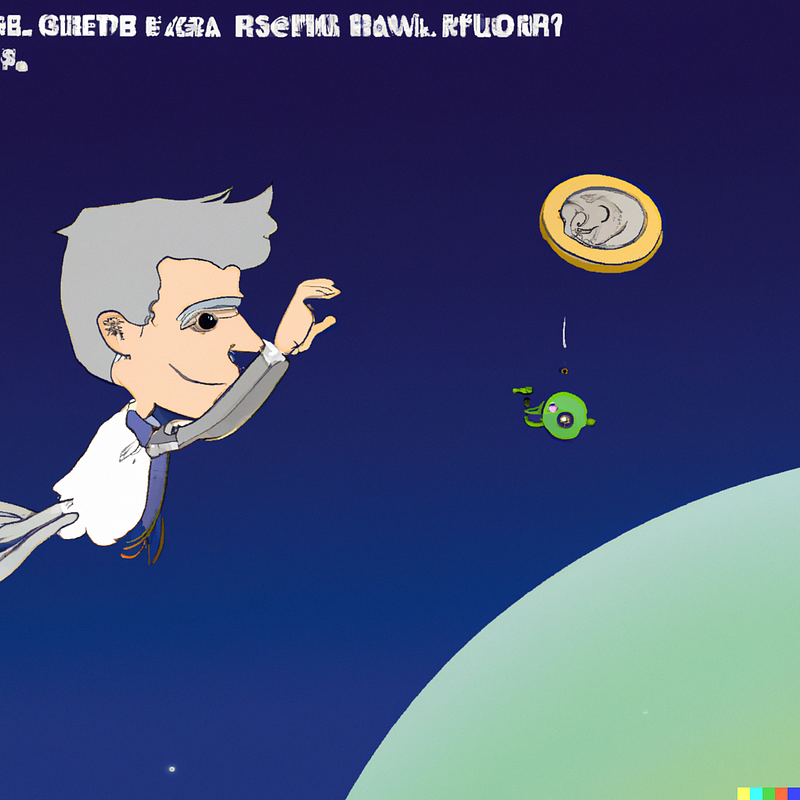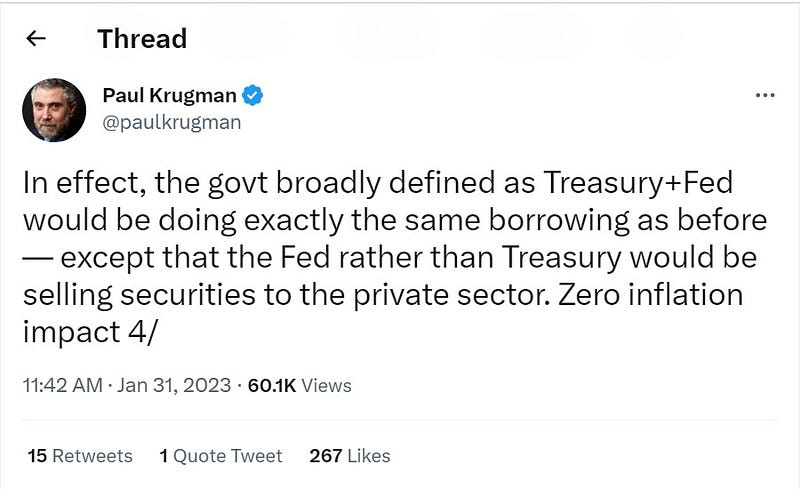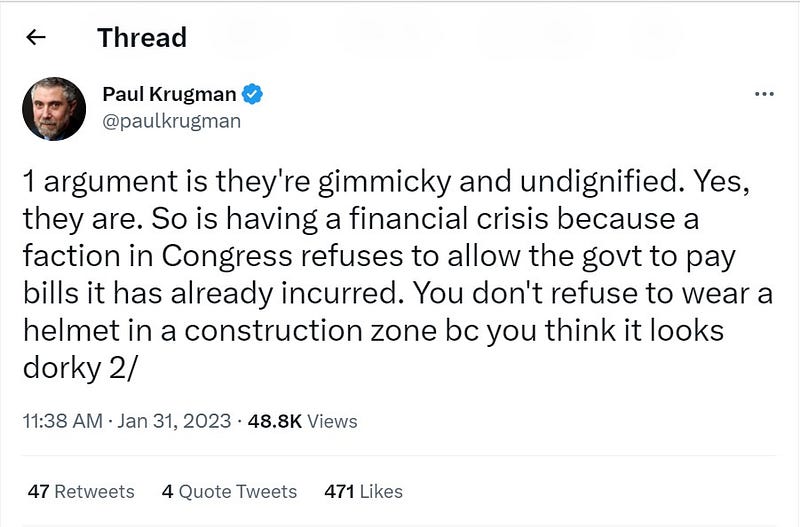Mint the Coin [Repost and Update]
One Coin to Rule Them All: Explaining the #mintthecoin Phenomenon
With another debt ceiling ‘crisis’ looming, the time is ripe for a plethora of economists, journalists, and twitter-goers to opine on the issue. I say ‘crisis’ because the debt ceiling is more of a politically-charged gimmick than anything else, but I don’t want to focus on that right now. Instead, I want to spend some time outlining an unconventional solution to the debt ceiling that has gained traction over the past few years: minting a trillion dollar coin. On Twitter, you’ll see this commonly referred to as #MintTheCoin.
What is the debt ceiling and the issue it creates?
The government of the United States is like a big family. Just like how a family has to pay bills and taxes, the government also has to pay its bills and taxes. But sometimes, the government doesn’t have enough money to pay all its bills, so it has to borrow money from other countries. That borrowing limit is called the “debt ceiling.”
To avoid the debt ceiling, or the need to borrow more money, there’s an idea of creating a new coin that’s worth a lot of money. That coin is called the “trillion dollar coin.” The US Treasury would create new money out of thin air by depositing a platinum (yes, the platinum part is important) coin with a face value of $1 trillion at the Federal Reserve. This would increase the amount of money the government has, and thus, it would be able to pay its bills without borrowing more money.

DALL-E generated image of “Digital Art of the United States Government making a trillion dollar coin.” This isn’t close to what the coin would look like. It has to be platinum, for starters.
How minting the physical coin would work:
- The order would be called by the Secretary of Treasury before the debt ceiling is hit.
- A platinum coin would be minted after it is struck at West Point.
- After being minted, it would theoretically* be accepted by the Fed.
*we will get into this a bit more below.
- At this point, you can melt the coin, put it in a museum, or put it on a rocket ship to Mars. Depends how creative the Fed is feeling that day.

A DALL-E generated photo of “Jerome Powell sending a coin to another planet”
What’s the problem?
So we’ve established that a) we can actually do it and b) it would avoid our debt ceiling issue. So what’s the problem?
There are a few criticisms of this solution. The ones I most commonly see thrown around are that it would cause inflation and that it’s too gimmicky.
I find both of these criticisms not terribly concerning.
Regarding inflation
The coin would just be used to pay off debts as if the ceiling was raised, which would ultimately happen anyway. It’s not directly injecting one trillion dollars into the economy. Furthermore, as Josh Barro points out in his newsletter…
…the coin would not go into circulation - Treasury would deposit it with the Fed. Then, the idea is that, as Treasury used its new cash stockpile to pay the government’s bills, the Fed would sell Treasury bonds into the open market, as a substitute for the bonds Treasury itself isn’t allowed to sell right now…In theory, this should all wash, with no effect on the money supply compared to a normal scenario where Treasury borrows and spend…
All of this states that we’re not really adjusting the money supply in any drastic way.
Concerns over inflation are always present. In 2008, when the Fed embarked in Quantitative Easing, a massive increase in the balance sheet to levels previously untested, there were fears that the increase in the money supply would cause rampant inflation and cripple the economy. But alas, we got a decade of record-low inflation because this money stayed in the financial system and avoided the real economy.
Regarding the ‘gimmick’ criticism
Well, so is the debt ceiling and the political infighting that surrounds it. So are some other solutions proposed to fix this issue, like premium bonds. The way we move around money in the government to temporarily avoid the debt ceiling is a gimmick. The whole thing is gimmicky, and I find this solution no less so.
Famed economist Paul Krugman agrees with my logic regarding these two points.


More serious concerns
That all said, I do think are other issues that are less often discussed but more serious:
It would politicize the Federal Reserve
If they even accepted the coin in the first place: As I mentioned earlier, in the situation where we do mint the coin, the Fed would accept said coin from the Treasury. The problem here is that the Fed, as it’s constructed, said it might not accept a trillion dollar coin. It doesn’t have to. And, even if they did end up accepting it, this would essentially be the Fed stating that they are participating in an administration’s effort to circumvent the House of Representatives in creating fiscal policy. They would help one party in power bypass what is supposed to be a bipartisan compromise. This would set a difficult precedent of using the Fed as a political tool moving forward, regardless of the party in power.
Economic expectations are too unpredictable
As described earlier, while inflation wouldn’t be an issue on paper, inflation is still a byproduct of expectations. If people believe there will be inflation, that can cause inflation, just or not. So if the market doesn’t believe debt would end up being issued, it would cause inflation expectations to rise, which would likely in turn cause inflation to go up. Furthermore, if this solution is publicly advertised, then the public would surely catch wind of ‘the government creating a trillion dollars out of thin air,’ which could also cause inflation expectations to rise. (FWIW, I think there are ways to prevent public expectations from rising, but no guarantees)
Conclusion
Ultimately, there are some very valid reasons to not move forward with minting the coin, and it’s probably best to not seriously consider this idea; however, as the United States’ political scene gets more and more polarized, the financial issues we face will get more and more challenging to resolve. So, if we’re going to need to get unconventional, don’t write off #minthecoin.
A Quick 2025 Update
Some time has passed since the publishing of this article, and this idea continues to resurface every time a debt ceiling crisis rolls around. From a policy perspective, not much has changed - this idea continues to be nothing more than a thought experiment.
Back in 2023, although I wouldn’t have endorsed this idea, I would say I was moderately intrigued and could at least entertain the conversation. Today, however, I figure it’s best we leave this idea behind. Minting the coin is too politically toxic in an already politicized country. We don’t need one party or another to try and take this non-traditional measure that bypasses Congress’s oversight of fiscal policy. Additionally, while actual liquidity may not be drastically affected, I’m far less confident that this idea would not cause inflation. I just think the optics of “creating $1T out of thin air” still carries too much potential to unsettle investors and stoke inflation fears. Inflation is all about expectations and credibility…the more non-traditional debt-avoidance routes we take, the less credibility we will have, which will likely increase inflation anyway.
Until we are really up against the wall (which I worry about more and more these days) I’d prefer if we never see this coin made. Save it for debate with your econ buddies.